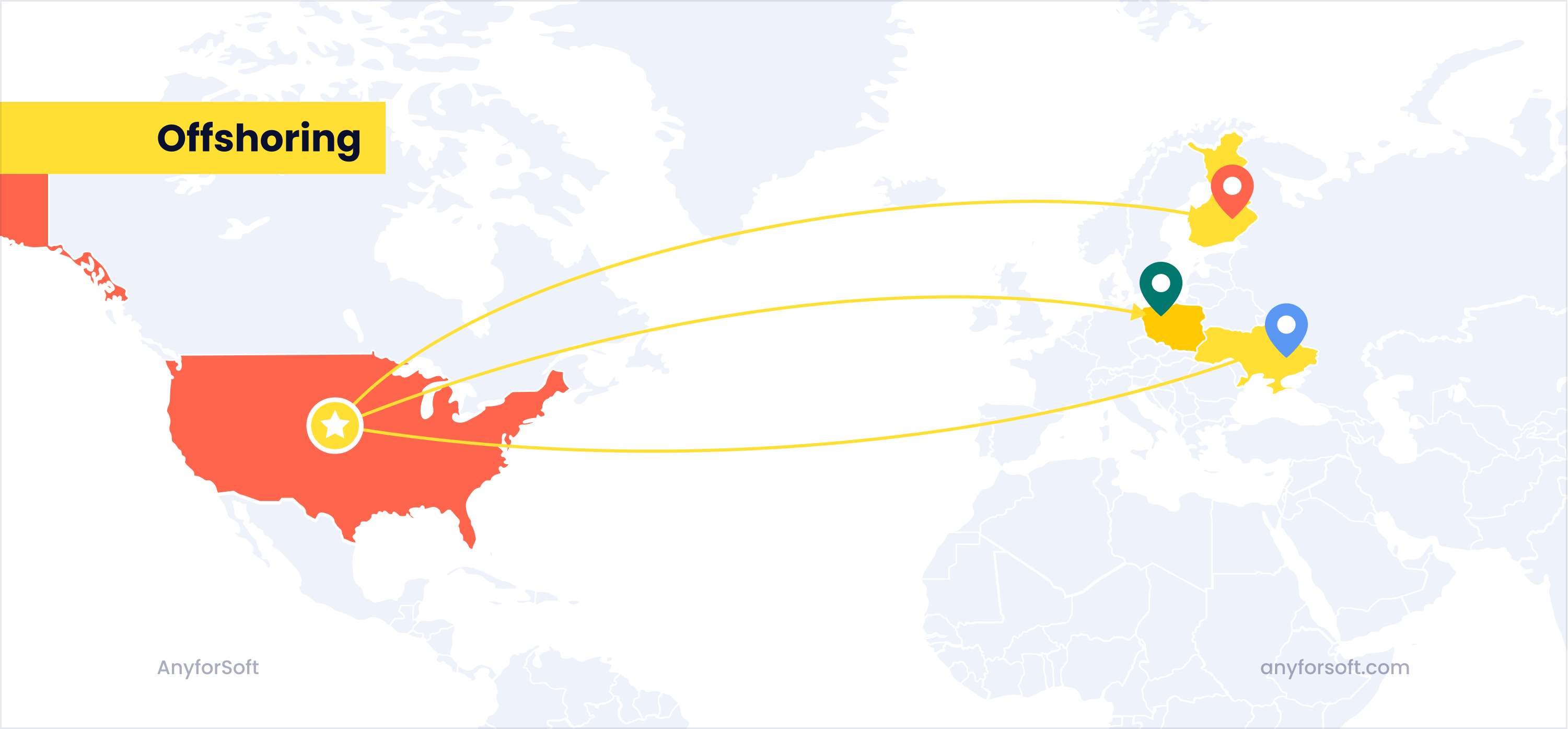So you’re planning a new project and need a team to turn your idea into a competitive digital product. Unfortunately, your in-house developers are too busy with current tasks, or perhaps their expertise is not sufficient to create what you want.
What’s your solution? You guessed it right—it is outsourcing.
Outsourcing is one of the quickest ways to find experienced specialists and bridge the talent gap. Many digital companies prefer this option over building in-house teams, as it is way cheaper and eliminates recruiting challenges. No wonder the global market of outsourced services has reached the 92.5 billion dollar mark and continues to grow.
There are three models you can opt for when outsourcing: offshoring, nearshoring, and onshoring. If you’ve never outsourced a project before, you must be wondering which model to choose and why. That’s exactly what this article is going to help you with.
In the following paragraphs, AnyforSoft compares nearshoring vs offshoring and onshoring, describes their differences, and reveals the pros and cons of each option so that you can make the right decision.
Enjoy!
What is offshoring?

Offshoring is an outsourcing model in which you hire a third-party company from a distant country, commonly one that is located on another continent. For example, if you’re in the US, hiring a development team from Ukraine would be offshoring.
Offshoring is quite popular among IT companies as it enables them to dramatically reduce expenses by outsourcing projects to places where labor is much cheaper. Besides cost efficiency, this model offers a large talent pool: you can choose any country that has talented specialists with the industry-specific expertise required for your project. By the way, you can find out the most popular outsourcing destinations in the IT industry by checking out this article.
As for the downsides, offshoring implies working in different time zones: your team will likely be working while you’re asleep, and vice versa, which will hinder communication. In addition to that, business meetings will become an issue—to meet your teammates in person, you will have to pay through the nose for flying tickets. Last but not least, let’s not forget about language barriers and cultural differences, which may also negatively affect business processes.
Pros and cons of offshoring
Pros:
- The cheapest option of the three. Good for companies with low budgets.
- Unlimited talent pool. Instead of sticking to neighboring countries, you are free to choose any place with the best quality-price ratio.
Cons:
- Different time zones hinder communication.
- Business meetings become an issue due to high travel costs.
- Language barriers and cultural differences may negatively affect software development processes.
How does nearshoring work?

Nearshoring implies staff augmentation by hiring developers from a nearby location, often from a neighboring country or at least one located on the same continent. For example, if you’re in the US, outsourcing a project to Mexico would be nearshoring.
Comparing offshoring vs nearshoring, the latter is more expensive, although not as expensive as building an in-house team. On the other hand, nearshoring has the advantage of geographical proximity, which facilitates business meetings. In addition to that, cultural differences won’t be so prominent since you and your team will be on the same continent.
Speaking of the downsides, nearshoring won’t save you from language barriers. Besides, finding talented people in a nearby country might be challenging—the talent pool will be limited to your continent. And as we already mentioned, this option is more expensive than offshoring, which is a deal-breaker for many.
Pros and cons of nearshoring
Pros:
- Geographical proximity facilitates business meetings. They become much easier than when your software development team is in a distant country.
- Cultural differences won’t be so prominent. You will likely have similar values and working styles.
Cons:
- This outsourcing approach is more expensive than offshoring.
- Language barriers may still occur.
- The talent pool is limited—it might be challenging to find specialists with the skills required to handle your project.
Basics of onshoring

In general terms, onshoring is a team extension approach in which you outsource your project to a team located in another city of your country, usually one with lower labor costs. For example, if you’re in New York, hiring a team from Portland would be onshoring.
Comparing onshoring vs offshoring and nearshoring, the first option is the most convenient in terms of geographical proximity. You as a business owner will be able to organize regular meetings, which will accelerate development processes. Besides, you won’t have to deal with cultural differences and language barriers, guaranteeing effective communication. Lastly, by hiring a team within your country, you contribute to its economy, which is a good thing.
Now to the downsides. Onshoring is the most expensive outsourcing model of the three (provided that you live in a country with high developer salaries). Also, the talent pool is the tiniest, so finding the right specialist may be challenging.
Pros and cons of onshoring
Pros:
- The most convenient option in terms of geographical proximity—regular business meetings won’t be an issue.
- Similar time zones.
- No cultural differences and language barriers are guaranteed, so you can count on a stable workflow.
- Onshoring is a good way to contribute to the economy of your country.
Cons:
- The most expensive option. If you live in a country where software development is costly, you should probably opt for offshoring or nearshoring.
- Finding local talent with the skills required for your project might be challenging due to a small talent pool.
Nearshoring vs offshoring vs onshoring: which option should you choose?
Now that we have compared offshoring vs onshoring and nearshoring, it shouldn’t be difficult for you to choose an option that best fits your business needs. And if you have a very tight budget, the odds are you will opt for offshoring. Personally, we consider it the wisest option, and here’s why.
Let’s be completely honest: it all boils down to money. Business owners opt for outsourcing because it is the cheapest way to solve their problems. Of course, outsourcing a project to a distant location is inconvenient in many ways, but considering that you’re saving thousands of dollars a month, it’s completely worth it. Besides, the downsides of offshoring we described above are not that bad.
Take different time zones, for example. At first, you might assume that it's terrible, but if you think about it, you can actually turn it to your advantage. For instance, suppose you wanted to provide 24/7 technical support for your customers. If you were to hire employees in your country, you would have to pay them extra for working at night, not to mention that finding someone willing to work night shifts would be daunting. However, if you outsourced your project to a country with a different time zone, you would have a team that works while your in-house staff is asleep. Besides, you and the outsourced team would still have many work hours that overlap—you could use those for communication.
Now let’s talk about the language barrier. Sure thing, it is a major issue, but there are plenty of countries with a high level of English proficiency. Take Ukraine, for example. 80% of its IT community speaks English well, so you won’t face any communication issues. Thus, offshore software development in Ukraine might be your perfect solution.
As for business meetings, it will surely be hard to meet with your team when you’re thousands of kilometers away. But in the digital world we currently live in, face-to-face meetings are not that necessary. After all, we have Zoom and Google Meets, so we can easily discuss business matters there, can’t we?
Conclusion
We hope that this article helped you understand the difference between offshoring and the other options and choose the right outsourcing business model. While we personally think that offshoring is the best way to go, the final decision is up to you. If you believe that nearshoring or onshoring better suits your business requirements, then go for whatever you think is right.
However, if cost savings is your primary concern, you should definitely outsource your business processes to a distant country where labor is much cheaper.
As a Ukrainian IT company, AnyforSoft is ready to work on your project, no matter how large and complex it is. We will build a professional development team that will turn your idea into a successful digital product. Most importantly, we will do everything it takes to develop a solution in accordance with your vision so that you will be 100% satisfied.
Contact us right now and let’s work on a project together!
